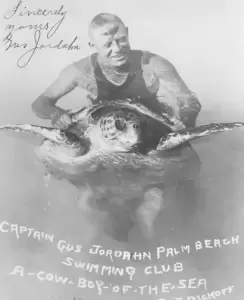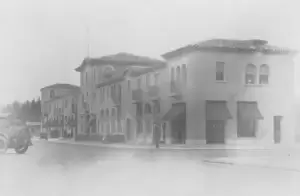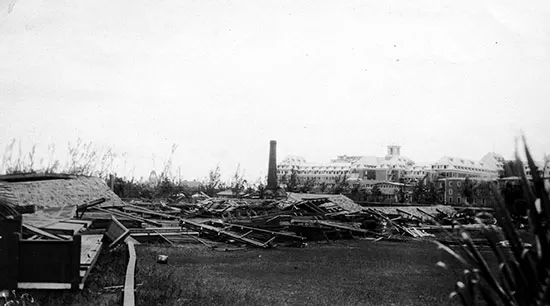Gus’ Baths and the Pier
 Peter G. “Gus” Jordahn (1881-1938) was born in Denmark, where he was a seaman and an army officer; he immigrated to New York in 1904. Jordahn and his bride, Johanna Rasmussen, honeymooned in Palm Beach in 1911 and soon made it their home.
Peter G. “Gus” Jordahn (1881-1938) was born in Denmark, where he was a seaman and an army officer; he immigrated to New York in 1904. Jordahn and his bride, Johanna Rasmussen, honeymooned in Palm Beach in 1911 and soon made it their home.
Gus Jordahn ran The Breakers Casino, a bathhouse for swimming, until 1914, when he built a wooden bathing pavilion at the end of Sunset Avenue in Floral Park. In 1923 he replaced his bathhouse with a Spanish style building, with a special pool for the Palm Beach Swimming Club. Later it became the Sun and Surf Club and was used by guests of the Biltmore and Whitehall Hotels, when Abraham M. “Sonny” Sonnabend and partners owned all three businesses.
Jordahn opened Gus’ Baths at the east end of Worth Avenue, which he expanded to two floors, with shops downstairs and 16 apartments on the second floor. He added a boardwalk with three gazebos, three heated saltwater pools, and a tunnel to the beach. Gus’ Baths was the only bathing beach open year-round in Palm Beach and was popular with West Palm Beach residents.

Across from Gus’ Baths, Jordahn built the 1,000-foot Rainbo Pier in 1924, a favorite fishing spot. According to his niece Kathryn J. Rybovich, Jordahn entertained visitors by jumping off the pier to swim with sea turtles, “even going so far as to take them over to his pools.” Here he founded Cowboys-of-the-Sea, in which all members had helped save someone from drowning; membership was for life. Jordahn developed and patented the Sug-Ooter Roll, a life preserver nicknamed the Palm Beach Roll.
Claude Dimick Reese Jr. grew up in Palm Beach and recalled Gus’ Baths:
They had some diving towers that you’ll never see again. They had one there that was a three-decker. … I don’t recall if there were even any lifeguards—there must’ve been a lifeguard somewhere. But we kids would go in there and pay our dime or whatever it was. … [W]e’d keep daring one another over a period of time to go higher and higher till we all pretty much got to the point where we’d dive off of that top one. I don’t remember any of us getting anything more than bruises.
Claude Dimick Reese Jr.
Royal Poinciana Hotel
During the 1928 storm, part of the building was tilted off its foundation. Hotel management decided to tear down the damaged section to avoid costly repairs. The baseball diamond and stands were destroyed, as were most of the gardens. Talk started that the hotel had outlived its usefulness. In the summer of 1934, demolition began. Materials were sold and used in more than 500 local buildings. The exterior of Memorial Presbyterian Church on Olive Street was entirely constructed from the chimney bricks; the ballroom’s parquet floor was installed in the auditorium.


